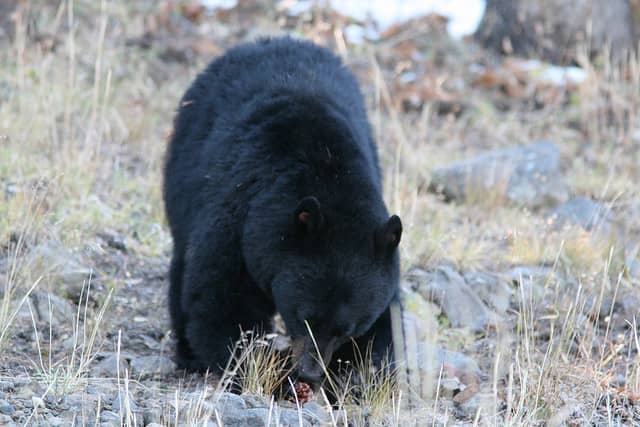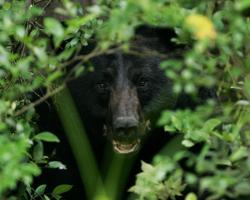Bear Activity on the Increase in Alabama
OutdoorHub 07.11.11

 Numerous species of wildlife become more active as seasonal changes trigger various physiological responses. Some species migrate and others increase their movement patterns mostly in efforts focused on the propagation of their species. Many species perform this annual ritual including songbirds, butterflies, and even bats, but none cause quite the commotion in Alabama as that of the black bear.
Numerous species of wildlife become more active as seasonal changes trigger various physiological responses. Some species migrate and others increase their movement patterns mostly in efforts focused on the propagation of their species. Many species perform this annual ritual including songbirds, butterflies, and even bats, but none cause quite the commotion in Alabama as that of the black bear.
While typically not a common sight in most of Alabama, a flurry of black bear sightings throughout the State has been the case this year including areas of Holly Pond, Double Springs, Boaz, Cullman, Birmingham, Roebuck, Lake Harding, Auburn, Atmore, Mobile and Macon County. However, most people may not know that black bear are common in parts of Alabama; occupying an array of habitats, some quite close to humans.
The southwestern section of the state in Mobile, Baldwin, and Washington counties is occupied by the Florida subspecies of the American black bear. The majority of the bears in the state are the Florida subspecies, which is not an uncommon sight in the counties listed above. Black bear sightings north of this latitude are typically black bears of the Eastern subspecies. While they are not as abundant, their distribution is typically associated with the southern boundaries of the Appalachian Mountains in Alabama.
Black bears of the southeast are, as the name states, black, with a brown muzzle and sometimes they have a white patch on the chest often referred to as a blaze. They stand about three feet high at the shoulder and range in weight from 150-350 pounds for adult males and 120-250 for adult females.
While classified as a carnivore, black bears are actually poor predators and are more omnivorous, mainly concentrating on vegetative matter for the bulk of their diet and are quite opportunistic in monopolizing abundant food sources. Common food sources include fruits, berries, and acorns of a variety of native shrubs and trees, but bears will sometimes take advantage of agricultural crops such as corn, wheat and sugarcane. Occasionally, they will also damage apiaries in their quest for honey.
By nature, black bears are shy, reclusive animals, and will frequently flee at the first sight of humans. Most sightings occur during the spring and summer as adult male bears greatly increase their range of up to 40,000 acres in search of receptive females. Younger bears also become quite visible as they are dispersed from the territories of other adult bears and in search of establishing a territory. Either situation exposes the bears to unfamiliar territories and often to hazards such as highways. One bear met its unfortunate fate this year as a vehicular mortality on I-85 near Tuskegee, Ala.
Typically, black bears utilize some sort of drainage corridor for their movements, be it a creek or river bottom, ditch or drain. However, due to loss of habitat in many areas of the state, bears will utilize a wide array of habitats in their movements, which also increases their visibility to the public.
Most problems with black bears stem from their quest for food, particularly in years where natural food sources are in short supply. Their acute sense of smell sometimes directs them to areas that increase their likelihood for conflicts with humans. Household garbage can be very attractive to bears and an effort should be made to either secure it to a degree where bears cannot gain access to it or keep the garbage inside until the day of pick up. Only feed outdoor pets the amount of food that they will consume in a short time period leaving no residual items that might attract a bear.
The feeding of birds and other wildlife also increases the possibility of attracting bears to your property. A bear that becomes habituated to associating a residence with food can possibly lose its natural fear of humans, which is the bear’s most important survival mechanism. Although not normally aggressive, bears are wild animals and therefore their behavior is unpredictable. The purposeful act of feeding them is highly discouraged by all wildlife professionals and can lead to dangerous consequences.
The black bear represents an important wildlife resource in Alabama’s woodlands. If you do see a black bear, don’t panic, but consider yourself lucky for you’re one of the few individuals that have experienced such a sight. Their population is relatively low and is currently estimated at hovering around 50 individuals for the state. Habitat loss, human disturbance, vehicular collisions and illegal killings are substantial obstacles that the black bear must endure to continue to occupy our state.
An informed and educated public is essential to the survival of the black bear. Additional information on Alabama black bears can be found at websites such as the Alabama Black Bear Alliance, www.alabamablackbearalliance.org, the Alabama Wildlife Federation, www.alabamawildlife.org and the Alabama Division of Wildlife and Freshwater Fisheries (ADCNR), www.outdooralabama.com. In addition, for those who do observe bears, please refer to the Alabama Black Bear Alliance website to complete an online report form or contact ADCNR Wildlife Biologist Keith Gauldin at the Alabama Wildlife and Freshwater Fisheries District V office at 251-626-5474.
The Alabama Department of Conservation and Natural Resources promotes wise stewardship, management and enjoyment of Alabama’s natural resources through five divisions: Marine Police, Marine Resources, State Lands, State Parks, and Wildlife and Freshwater Fisheries. To learn more about ADCNR, visit www.outdooralabama.com .
Contact:
ADCNR Wildlife Section
334-242-3469

